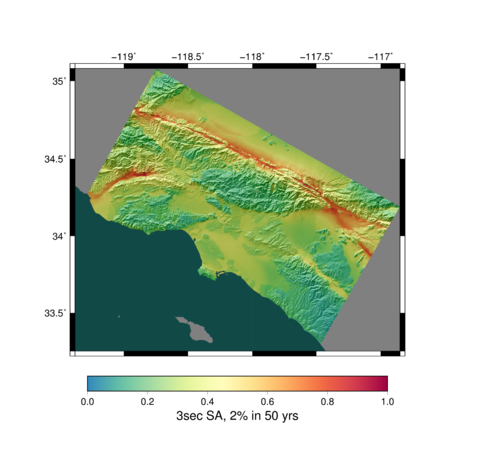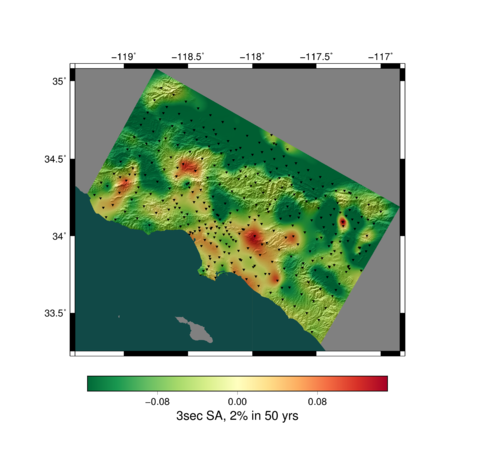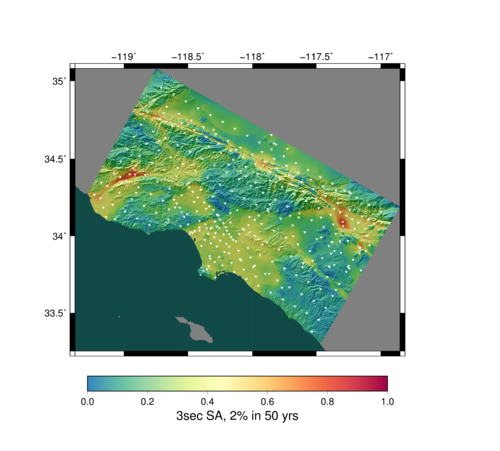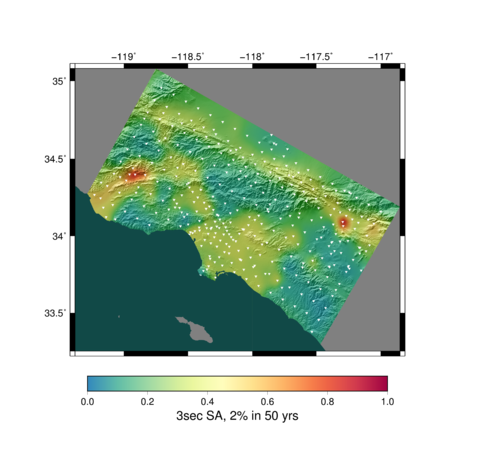Difference between revisions of "CyberShake Map Generation Procedure"
| Line 1: | Line 1: | ||
CyberShake hazard maps are generated using an interpolated difference approach. This procedure is outlined below. | CyberShake hazard maps are generated using an interpolated difference approach. This procedure is outlined below. | ||
| + | |||
| + | == GMPE Basemap == | ||
First, a high resolution GMPE basemap is calculated. This GMPE basemap uses a high resolution Vs30 map as well as the Z1.0 and Z2.5 from the velocity model used for the CyberShake study of interest (a new GMPE map is generated for each alternative velocity model). The ERF used in these maps is the same as used in CyberShake. | First, a high resolution GMPE basemap is calculated. This GMPE basemap uses a high resolution Vs30 map as well as the Z1.0 and Z2.5 from the velocity model used for the CyberShake study of interest (a new GMPE map is generated for each alternative velocity model). The ERF used in these maps is the same as used in CyberShake. | ||
| − | [[File:cs_interp_gmpe_basemap.png | + | [[File:cs_interp_gmpe_basemap.png|500px|GMPE Basemap]] |
| + | |||
| + | == CyberShake - GMPE Basemap, interpolated == | ||
Then, at each CyberShake site, the difference is taken between the CyberShake value and the GMPE basemap value. This XYZ scatter data is then interpolated onto a regular grid. | Then, at each CyberShake site, the difference is taken between the CyberShake value and the GMPE basemap value. This XYZ scatter data is then interpolated onto a regular grid. | ||
| − | [[File:cs_interp_diff.png | + | [[File:cs_interp_diff.png|500px|CyberShake - GMPE Basemap, interpolated]] |
| + | |||
| + | == Final CyberShake Interpolated Difference Map == | ||
These interpolated differences are then added on top of the GMPE basemap to generate the final CyberShake hazard map. This allows for the final map to keep the detail of the GMPE map, while exactly equaling the CyberShake value at each CyberShake site. | These interpolated differences are then added on top of the GMPE basemap to generate the final CyberShake hazard map. This allows for the final map to keep the detail of the GMPE map, while exactly equaling the CyberShake value at each CyberShake site. | ||
| − | [[File:cs_interp_final.png | + | [[File:cs_interp_final.png|500px|Final CyberShake Interpolated Difference Map]] |
| + | |||
| + | == Raw CyberShake Interpolation - No GMPE == | ||
| − | + | Here is how the CyberShake data looks like if interpolated by itself, without using the GMPE interpolated difference method | |
| − | [[File: | + | [[File:cs_interp_raw_cs.png|500px|CyberShake Raw Interpolation]] |
Latest revision as of 23:27, 29 November 2016
CyberShake hazard maps are generated using an interpolated difference approach. This procedure is outlined below.
Contents
GMPE Basemap
First, a high resolution GMPE basemap is calculated. This GMPE basemap uses a high resolution Vs30 map as well as the Z1.0 and Z2.5 from the velocity model used for the CyberShake study of interest (a new GMPE map is generated for each alternative velocity model). The ERF used in these maps is the same as used in CyberShake.
CyberShake - GMPE Basemap, interpolated
Then, at each CyberShake site, the difference is taken between the CyberShake value and the GMPE basemap value. This XYZ scatter data is then interpolated onto a regular grid.
Final CyberShake Interpolated Difference Map
These interpolated differences are then added on top of the GMPE basemap to generate the final CyberShake hazard map. This allows for the final map to keep the detail of the GMPE map, while exactly equaling the CyberShake value at each CyberShake site.
Raw CyberShake Interpolation - No GMPE
Here is how the CyberShake data looks like if interpolated by itself, without using the GMPE interpolated difference method



